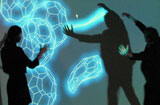![]()
![]()
![]()

![]()
At the Intersection of Art and Science: nano
Two UCLA professors-media and net artist Victoria Vesna and nanoscience pioneer James Gimzewski-are at the forefront of the intersection of art and science. Their groundbreaking project, "nano," now on view at the Los Angeles County Museum of Art's Boone Children's Gallery, presents the world of nanoscience through a participatory aesthetic experience. The exhibition, a collaboration between LACMALab and a UCLA team of nanoscience, media arts, and humanities experts, is free to the public and runs through September 6, 2004.
The exhibition seeks to provide a greater understanding of how art, science, culture and technology influence each other. Modular, experiential spaces using embedded computing technologies engage all of the senses to provoke a broader understanding of nanoscience and its cultural ramifications. The various components of "nano" are designed to immerse the visitor in the radical shifts of scale and sensory modes that characterize nanoscience, which works on the scale of a billionth of a meter. Participants can feel what it is like to manipulate atoms one by one and experience nano-scale structures by engaging in art-making activities.
The project installations were conceived and designed by Vesna (chair of the Department of Design | Media Arts) and Gimzewski (Department of Chemistry) and created together with a team of their graduate students. The exhibition's architecture was designed by Sharon Johnston, Mark Lee and Anne Rosenberg of Johnston Marklee & Associates. Johnston and Lee are on the faculty of the UCLA Department of Architecture and Urban Design and Rosenberg is an alumna. Professor N. Katherine Hayles (Department of English), also with graduate students, developed the text component within the gallery.
The architecture of "nano" actively creates synergy with the exhibition's media installations and the visitors. Inside the 10,000 square-foot gallery, the architectural surfaces create flowing layers of enclosed and semi-enclosed spaces for viewing the exhibition's various components.
In the central area of the exhibition, visitors enter the large Inner Cell, where they interact with molecular forms through their hands and feet as well as through their eyes and ears. With just their shadows, they are able to manipulate and reshape large-scale projected images of a particular form of the carbon molecule, commonly known as a "buckyball." They also encounter audience controlled robotic balls, or "atoms," that roam the space and project high-pitch sounds, emulating the physical actions of cells.
To reinforce the understanding of the nano scale, one installation connects to the process of the recent creation of a sand mandala at LACMA, from a nano-scale view of a grain of sand to the completed eight-foot mandala (a cosmic diagram and ritualistic symbol of the universe, used in Buddhism and Hinduism).
Visitors can encounter the Quantum Tunnel, where images of their faces are projected on two opposing walls. When visitors in either of these spaces activate a camera, their images are captured and projected on the nearby wall. As they move through the connecting corridor to the opposite end, the two projected images are juxtaposed and become distorted. When another visitor passes through the corridor, the facial images are again disturbed and altered, fractured into particles and waves.
The LACMALab art studio allows visitors to use open-ended materials for focused activities such as molecular model making. In addition, visitors are invited to "draw" in space, using a cutting-edge computer design program and tool, created by Steven Schkolne at Caltech, that translates physical movements into virtual 3-D images. The natural world and digital display merge in this exploration of crystallography, creating a shared space where viewers experience physical properties beyond traditional visual means.
"nano" is presented as part of LACMA's NexGen youth membership program and is the fourth exhibition organized by LACMALab, the museum's experimental research and development unit, which initiates new models of presenting art and engaging audiences of all ages through artists' projects. LACMALab's director, Robert Sain, and its exhibition coordinator, Kelly Carney, worked in conjunction with Carol Eliel, curator of Modern and Contemporary Art at LACMA, to collaborate with the exhibition team on all aspects of "nano."
More information is available online at nano.arts.ucla.edu.